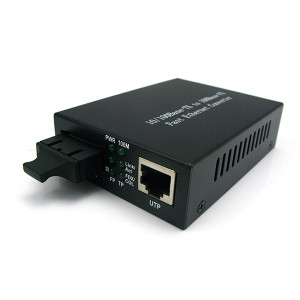Introduction
Fiber Media converters are flexible and cost-effective devices for utilizing and optimizing fiber links in all types of networks.They are key components of optical networking because its long-distance operation, high bandwidth capacity and reliability make fiber optics probably the most desired channel for data communications.There are lots of types of Media converters,today ,we’ll concentrate on talking something about the Ethernet Media Converters.
What is a Ethernet Media Converters?
An Ethernet Media Converter enables two network devices with copper ports to become connected over extended distances via fiber optic cabling.It is also useful if EMI/RFI emissions or interference are of concern as the device will convert the electrical data signals into light pulses which will travel within the fiber optic cabling. This has two additional benefits. It electrically isolates both network nodes from one another eliminating any ground loop concerns or voltage spikes from lightning. Additionally, it provides a measure of security for your network transmissions because it is virtually impossible to take advantage of the transmitted signal without detection.
How does an Ethernet Media Converter work?
Ethernet Media Converters normally have two types of ports; one for that copper (UTP/STP) side from the conversion, (usually an RJ45 jack), and one for fiber side, which could vary with respect to the unit (usually ST,SC or LC). Once you have selected the press converter that meets your needs, you just plug your copper network cable into the RJ45 jack and then make your link with your Fiber optic cabling. For the majority of unmanaged Ethernet Media Converters when you power up the unit you’re done with your installation.Because of the large number of different switch and converter products in the marketplace today, it is quite likely that your network uses switches from different vendors, or maybe different models of switch in the same vendor. In fact, if your network has already been using one switch with a built-in fiber port and you wish to connect the fiber port to a copper-only switch, you could do this by inserting an Ethernet-to-fiber media converter between the two devices.
Where are Ethernet Media Converters used?
Ethernet Media Converters are utilized wherever long network runs are needed that exceed the 100 meter maximum segment period of traditional copper UTP/STP for example large Corporate or University campuses, large high rise buildings or Municipal buildings that cover a wide area or wherever ground loops or voltage spikes from lightning may be reason to be concerned. You will also find these items wherever intense EMI/RFI that could interfere with your network exists such as Industrial/Manufacturing Facilities or perhaps in environments where the introduction of stray electrical signals are strictly regulated such as hospitals, clean rooms and aircraft just to provide a few examples.
Application Example
Point-to-Point Applications
A pair of media converters may be used in point-to-point connections that connect two UTP Ethernet switches (or routers, servers, hubs, etc.) via fiber, or to connect UTP devices to workstations and file servers.

Campus Fiber Application
Within this application example, 10/100 media converters are set up in a Redundant Power chassis for high-density fiber distribution from UTP switch equipment(A) in the network core. A UTP workgroup switch (B) is connected via fiber to the network core with a standalone 10/100 media converter. Another 10/100 converter enables fiber connectivity to some PC UTP port inside a fiber-to-desktop application (C). An Ethernet switch (D) is connected directly via fiber towards the media converter module at the network core.
Ethernet Media Converter in Fiberstore
Get more information about Fiberstore, click here!




